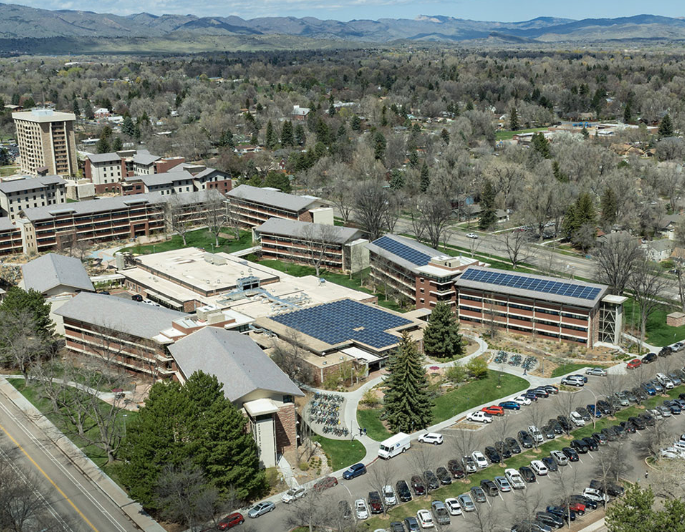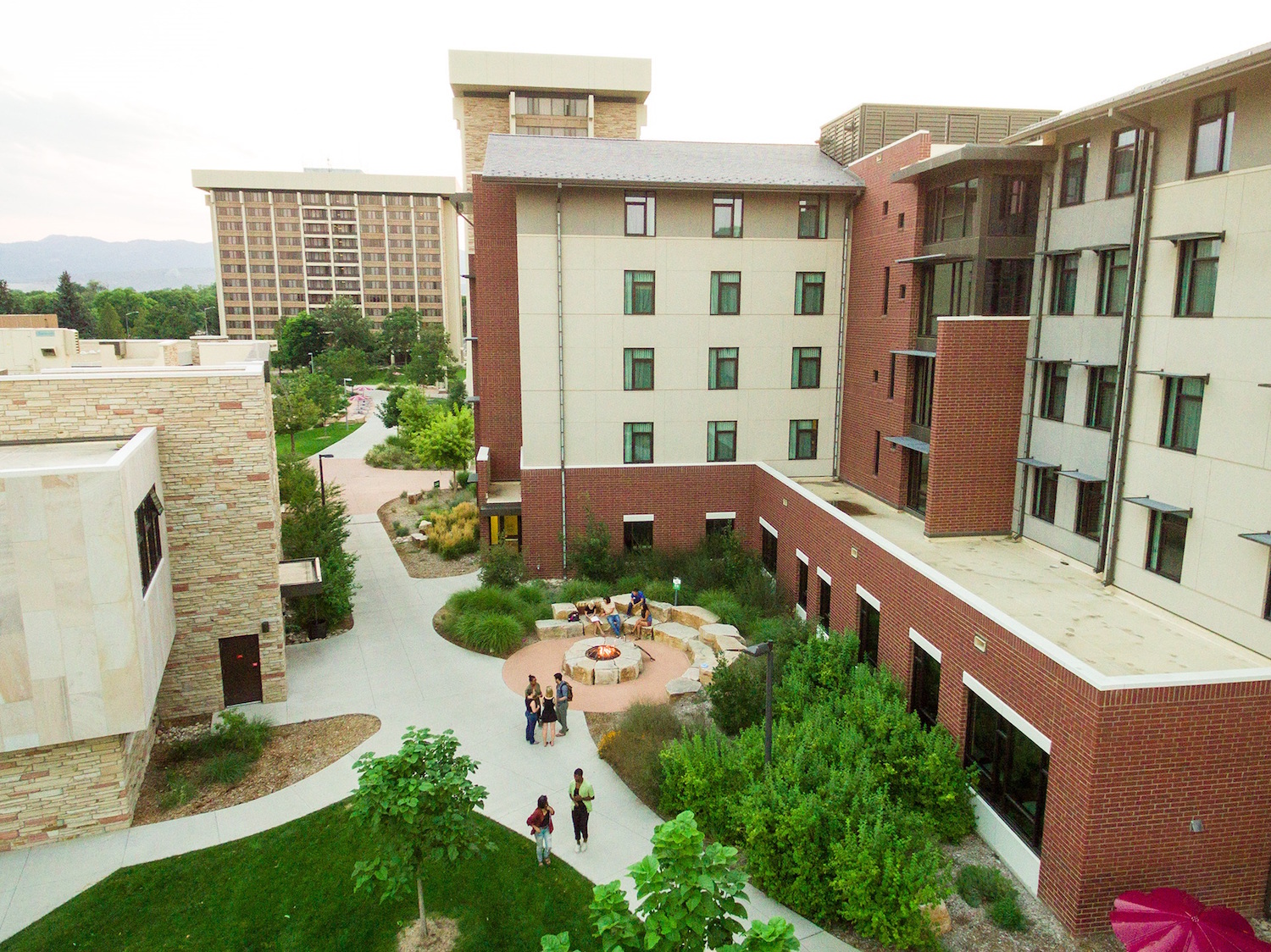

A look back at CSU’s Green Hall and Veteran’s Village in 1955 (left) and the same area today (right).
Colorado State University’s housing has evolved over the decades, a result of changing student demographics and needs. CSU has blended technology, aesthetics, and amenities into living spaces that cater to modern-day students and support student success. Today, residence halls are much more than a place to sleep (thus the shift away from the term “dorm”). They are communities where students live, learn, and grow.
Structures meet changing needs
The physical buildings developed as societal needs changed. In her book, Living on Campus: An Architectural History of the American Dormitory, architectural historian Carla Yanni notes that living in a residence hall has evolved over the years:
“In the 17th and 18th centuries, students were boys who needed moral guidance; in the 19th century, women began attending college in large numbers, always under protective eyes; as the concept of the adolescent emerged around 1900, youthful males were encouraged to delay adulthood; in the 1950s, students were military veterans eager to return to civilian life; and in the 1960s, they were members of a youth culture that administrators almost feared.”
CSU’s first students were mostly children of local farmers who lived at home and commuted to class on horseback. In 1881 the College Dormitory opened, its construction having delayed the start of the fall semester by three weeks. Women lived on the main floor with a matron who oversaw their conduct while men boarded on the second floor.
In Democracy’s College in the Centennial State, CSU historian James Hansen recalls how students comingled: “Social occasions for men and women students of this era were very limited… When a boy residing on the second floor wished to ask a girl for a Sunday date, he would sometimes communicate by tying a note around a weight, which was lowered, then swung back and forth until it tapped against her window. She would respond by attaching a reply to the string and giving it a sharp pull to indicate it should be drawn up.”
CSU residence hall timeline
| Building | Gender | Constructed |
| Rockwell | Women | 1940 |
| Vet Village (Quonset huts) | Co-ed | 1946 |
| Braiden (Student Services) | Men | 1948 |
| Lory and Faculty Apartments | Co-ed | 1950 |
| Green | Men | 1953 |
| Newsom | Men | 1954 |
| Ellis | Men | 1956 |
| Allison | Women | 1957 |
| Aylesworth | Men | 1957 |
| Parmelee | Women | 1962 |
| Braiden | Men | 1963 |
| Ingersoll | Men | 1964 |
| Edwards | Men | 1964 |
| Aggie Village | Family | 1964 |
| Corbett | Men | 1965 |
| Durward | Women | 1967 |
| Westfall | Men | 1967 |
| University Village | Co-ed | 1970 |
| International House | Co-ed | 1994 |
| Summit | Co-ed | 2003 |
| Academic Village | Co-ed | 2008 |
| Laurel Village | Co-ed | 2014 |
| Aggie Village | Co-ed | 2016 |
By 1893 the Dormitory Building was converted to academic purposes as enrollment at the college grew, and for several decades students were responsible for finding their own housing at fraternities, sororities, and local boarding housing. In 1937, the State Board of Agriculture – the governing body of the university at the time – authorized construction of a women’s dormitory, recognizing that housing was a factor in social and intellectual development for students.
This launched the era of single-gender dormitories on campus managed by house moms, with curfews for women and strict behavior expectations for men.
Following World War II, campus saw a big boom as more than 2 million veterans enrolled in colleges across the country. As enrollment at CSU surged from less than 1,000 students in 1945 to more than 1,600 by spring 1946, housing became a crisis. Ninety prefabricated units were bonded by the College while additional units were provided by the Public Housing Administration as war surplus buildings.
These Quonset huts, often described as tin cans cut in half, were quickly erected along Laurel Street in spring of 1946, creating Veteran’s Village where Corbett Hall now stands. The Quonset huts were notoriously hot in summer, very loud in storms, and cold in winter, but they provided veteran students and their families basic housing when it was needed most.
Recognizing that enrollment would only continue to grow and Veteran’s Village was temporary, the university invested in permanent campus housing. By 1949, there were three residence halls (Rockwell, Braiden, and South); 12 more followed in the next two decades, as well as four apartment communities (halls included Allison, Aylesworth, Corbett, Durward, Ellis, Edwards, Green, Ingersoll, Newsom, Parmelee, Durward, and Westfall; apartments included Aggie Village, Lory, Palmer, and University Village).
International House was constructed in the 1990s when the Palmer apartments were converted to office space.
Housing students today

The view of residence halls today on CSU’s campus.
Today’s students, having been raised in a digital age, require very different support and amenities in their living spaces. Several new halls (Alpine and Piñon in Laurel Village, Engineering, Honors, and Aspen in Academic Village, and Summit Hall) have been built on campus in the past 15 years to support enrollment growth, and the legacy halls have all undergone minor to significant renovations to provide WiFi, network connections, daylighting, low-flow shower heads, high-tech classrooms, and cozy study niches.
Student common areas (including spaces to dine, recreate, socialize, and study) also have changed dramatically, with the old cafeteria lines replaced with a Mongolian grill, custom pasta stations, and even a sushi robot. The old meatloaf or chicken-fried steak dining options in past decades have been replaced with salad bars stocked with greens grown at the university’s Horticulture Center, a wide variety of vegetarian and vegan options, and gluten-free menu items, all available to explore on an online menu.
The big expanses of parking lots and grass that once surrounded campus housing have been gradually replaced with pedestrian and bike paths connecting across campus, fire pits, slack lines, and pollinator-friendly landscaping including a couple of student-run bee hives. With garage doors that open, a bike shop that flows outside, and a number of study hammocks, the connection between indoors and outdoors has been enhanced in recent years. Housing has come a long way from the Quonset hut era.
Sustainability
Sustainability has been a driver in many recent renovation, construction, and infrastructure projects, including renewable electricity, more plant-based menu items, and energy-efficient lighting and heating/cooling systems, often qualifying for green building certifications and earning CSU national and international recognition. Among many initiatives, energy conservation, alternative transportation, composting, and student sustainability education and engagement have become an integrated part of the student living experience.
Updating, modernizing, and renovating spaces helps to keep students connected to campus. According to CSU Housing & Dining Services Executive Director Mari Strombom.
“By creating centralized shared amenities, such as dining and community spaces, more opportunities are available for students to make connections with students who live in other buildings, expanding the sense of community on our campus,” Strombom said.
Visit housing.colostate.edu/150years to take a fun look back at how students have lived on campus since our founding in 1870.
Marianne Wieghaus and Tonie Miyamoto of CSU Housing & Dining Services contributed to this story.